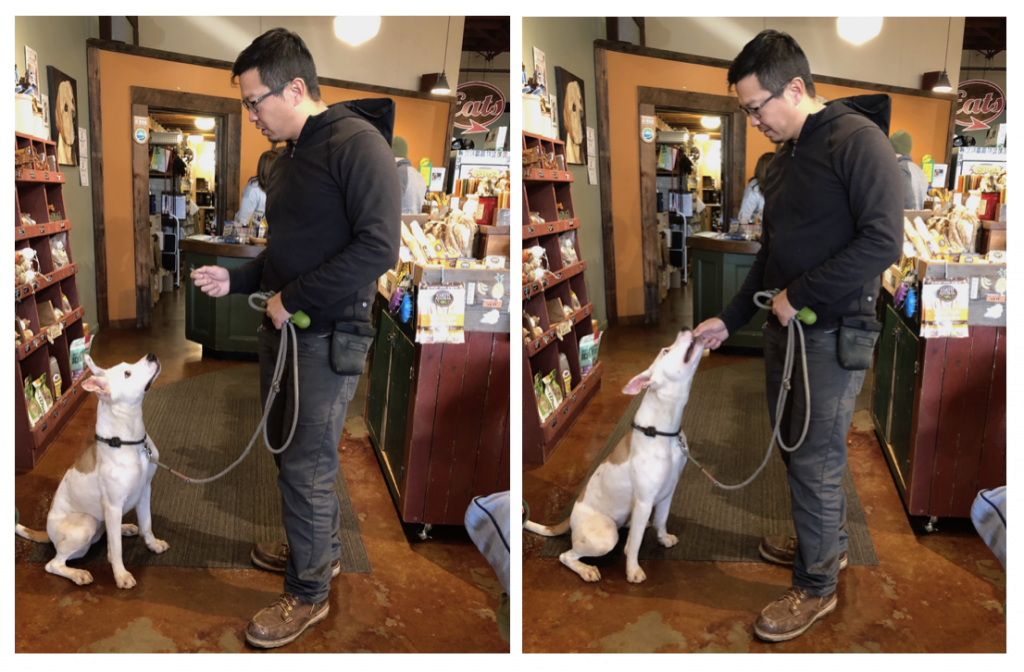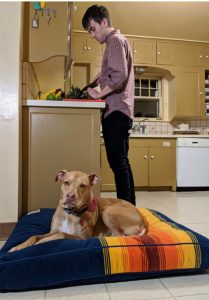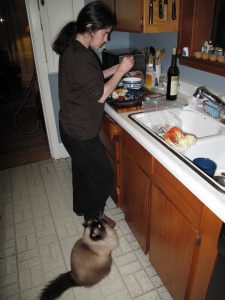Foundational Thinking For Creating Good Behavior in puppies (and kittens!) Part One
 Often we hapless humans try our best to tell our puppies (and kittens) what we want them to do or especially not do, yet the bad behaviors increase and we struggle to get them to be what we wish they would be, especially when it comes to attention-getting behaviors. I’m here to offer a few rules of thumb for most any behavior you don’t like. First, I’ll say that punishment doesn’t need to be part of the picture. Punishing him for wanting your attention can erode your relationship. It’s sweet that he wants your attention, but he’s asking for it in the wrong way.
Often we hapless humans try our best to tell our puppies (and kittens) what we want them to do or especially not do, yet the bad behaviors increase and we struggle to get them to be what we wish they would be, especially when it comes to attention-getting behaviors. I’m here to offer a few rules of thumb for most any behavior you don’t like. First, I’ll say that punishment doesn’t need to be part of the picture. Punishing him for wanting your attention can erode your relationship. It’s sweet that he wants your attention, but he’s asking for it in the wrong way.
A universal truth: Animals do what works for them.
Here’s a little attention getting scenario: You’re talking on the phone, and the puppy starts to whimper and bark at you. You ignore it for a time, and he gets louder. You tell your friend to hang on, and you turn and shout at the puppy, “Stop it! I’m on the phone!”. You go back to your conversation and he goes back to his barking. The trick is to think (in any similar situation) “What does he want?” In this example, he wants you to break away from what you’re doing, look at him, and pay attention to him. Have you just done all of these things? Hmm, he in fact got exactly what he wanted, and he thinks “Oh good. That’s how I get her attention”. You can’t really fault him for trying that again. You have unwittingly rewarded his bad behavior, and it will probably increase. Hurrying and getting a dog’s dinner to him faster just to shut him up really teaches him something you’re not going to enjoy.
Strategy #1: Ignoring behaviors you don’t like can be a useful tactic, though you really really have to be a rock. If he barks and barks and barks and you eventually break and tell him to cut it out, you have taught him endurance. “Bark long enough and they finally listen” is what you’ve taught him. We are no different: when we push the elevator button and the lights don’t light up, we jab at it again, and again, and maybe bang on it a few times before we give up and take the stairs. If we ignore the dog at first and then respond when the behavior escalates, we’ve only taught him, “If barking and whining’s not working, bark louder!” They’re not being turds on purpose, they’re doing what we’ve taught them works. If that elevator button never ever brings the elevator, you’d quickly learn to go straight to the stairs. If they’ve had a lot of practice barking to get attention, count on it getting a little worse before it gets better. Remember how you might have jabbed at that stupid broken elevator button in exasperation before you gave up? That’s called an extinction burst – they try and try and then really try, saying “Why isn’t this working???” Rewarding him when he finally gives up and becomes quiet for a few moments is useful in this moment. Being a rock in the future may help to extinguish this behavior but it can be easier combined with other strategies (read on).
Strategy #2: You could turn this attention-getting behavior around on him. If the question is “what does he want?”, your answer to the right behavior (the quiet puppy just staring at you with his Disney eyes without barking) might be to go closer to him and give him some petting and attention before he barks and hanging out with him while you talk on the phone. The answer to the “wrong” behavior (whining and barking) might be to give him the opposite of what he wants, which would be that he is put somewhere else that’s farther away from you and your attention for a little time out. You might say something like “Oops” or “Too bad” and march him without comment to the time out. No need to be mad, just decisive. After a few minutes of quiet you can get him and bring him back. If the barking happens again, “Oops” and another time out. If it doesn’t happen again, he certainly gets a little attention while you talk on the phone, and maybe a treat. Show him what does work, and react immediately to what doesn’t. This works for many things.
If you want him to stay seated and politely wait for a treat or a toy to be given to him without  jumping up to grab at it, have him sit and bring a treat down towards his mouth and if he tries to jump up and grab it, snatch it back; he’s chasing it away by jumping up. It starts its descent back to his mouth the moment he sits again. What does he want? The treat. What do we want? Stay seated. What works to make the treat come closer? Staying seated. What makes the treat get farther away? Breaking the sit. His choice. Dogs quickly switch strategies to what works, and avoid strategies that never work. His feet will start to stick to the floor to make that treat come all the way to him.
jumping up to grab at it, have him sit and bring a treat down towards his mouth and if he tries to jump up and grab it, snatch it back; he’s chasing it away by jumping up. It starts its descent back to his mouth the moment he sits again. What does he want? The treat. What do we want? Stay seated. What works to make the treat come closer? Staying seated. What makes the treat get farther away? Breaking the sit. His choice. Dogs quickly switch strategies to what works, and avoid strategies that never work. His feet will start to stick to the floor to make that treat come all the way to him.
We get customers to use this strategy when they wish their dog wouldn’t bark so much when they’re excited to be in the store. We recommend this strategy only when the dog loves to be in the store, and is after all the good stuff and attention that we give. If an animal is barking because they’re uncomfortable in any way, this wouldn’t be the solution, but if a dog is so happy to be there, losing access for a moment will mean something significant to her. We recommend that as soon as she dog starts barking, that the owner just say “Oops!” Or “Too Bad!” And matter-of-factly walk straight for the door. After a few moments of calming down, come right back in, and if the barking starts again, just repeat. Quite often it only takes a few times, and the dog starts trying hard to be quiet. What does she want? All the fun store things like treats, good smells, attention, treats… What happens when she barks? She has to go farther away from the things she wants! No drama, no punishment, just simple removal of the good things, which we show her she can actually keep her access to if she’s quiet.
 Strategy #3: it wouldn’t hurt to set him up for success with that phone call by filling a Kong, Topple, or LickiMat when you plan to be distracted so that he doesn’t practice his bad attention getting behavior when you need to get something done.
Strategy #3: it wouldn’t hurt to set him up for success with that phone call by filling a Kong, Topple, or LickiMat when you plan to be distracted so that he doesn’t practice his bad attention getting behavior when you need to get something done.
Strategy #4 – Go To Your Spot: For best success, the question you really have to have to ask is, “What do I wish he would do instead?” Is the answer “Lie down quietly”? If so, this is the behavior that needs to be rewarded. Having a mat in the room that you can have the dog settle onto is very useful, especially if you start to show him that if he goes there when you send him there, (or especially if he goes there on his own), good things come to him.
Something light but comfy will be best – a crate pad would do nicely. To start, get small pieces of two kinds of treats, one which is of medium value such as small pieces of a soft dog cookie like Shameless pet treats or Chow Down treats or a commercial training treat like Tricky Trainers (avoiding treats with artificial colors, preservatives like BHA and BHT and propylene glycol), and one which is of high value, which might be training treats that are made entirely of meats and organs like Real Meat treats, another soft jerky, or little bits of cooked chicken breast or cheese from your fridge. At first, you’re right there with him, encouraging him to come with you to the mat. You make a big deal about how neat this mat is. When he comes along and steps on the mat, you throw a medium value treat down on the mat. Call him away, then you can start encouraging him in a cheerful way to “go to your spot” (or whatever you want to call it) and point to it as you bring him all the way there, rewarding with a treat dropped on the mat, release him (“OK!” or “All Done!”, etc) and give him praise. Ask him to come away from the mat with you a little ways away, and then bring him back to the edge of the mat, pointing at it and saying it again. If he steps on the mat, mark it with a “Yes!” and another medium value treat falls on the mat. You could start to ask for a sit on the mat, rewarding with a medium treat dropped on the mat, and releasing him. You could then encourage him to lay down on it, mark it (“Yes!”) And hand him one high value treat. When this seems easy, start from another foot away or so – not too far, and point at the mat and use your command to go to it. See if he’ll walk away from you to go there. If so, immediately say “Yes!” and go to him and drop a high value treat onto the mat, and then one more (you’re adding value to doing the new, harder thing). Ask for a down. Say “yes” when he gets down, and hand him a high value treat, and release him. If he didn’t walk away from you from a foot away, do more reps of bringing him closer to it and pointing with your command, marking each time with “Yes!” and releasing him. Pretty soon he’ll be trotting there from a few feet away. Each time he gets on the mat, you mark it with “yes!” and come right over to reward it with the medium value treat, then ask for a down and reward it with a high value treat. **If he offers a down on the mat without being asked, he needs a high value jackpot.
What is a Jackpot? You want to cement the idea that laying down on the mat on his own is  THE thing you want out of this. A jackpot is a great tool you can use when a dog gets something exactly right, or makes significant progress towards your goal. Dogs and cats are funny. They don’t measure well but they can “count”. There’s very little to no difference in value between a high value treat that’s small and the same treat that’s bigger. It’s ONE good treat. What is far more exciting is multiple treats, given one at a time. One treat broken into 8 pieces and handed to them all at once in the palm of your hand is also ONE good treat. But 8 pieces given one at a time is EIGHT GOOD TREATS! Ding ding ding! Jackpot. This sticks with them, and they want it to happen again. They’ll want to repeat what worked to get them that neat jackpot.
THE thing you want out of this. A jackpot is a great tool you can use when a dog gets something exactly right, or makes significant progress towards your goal. Dogs and cats are funny. They don’t measure well but they can “count”. There’s very little to no difference in value between a high value treat that’s small and the same treat that’s bigger. It’s ONE good treat. What is far more exciting is multiple treats, given one at a time. One treat broken into 8 pieces and handed to them all at once in the palm of your hand is also ONE good treat. But 8 pieces given one at a time is EIGHT GOOD TREATS! Ding ding ding! Jackpot. This sticks with them, and they want it to happen again. They’ll want to repeat what worked to get them that neat jackpot.
Regularly marking the behavior (“Yes!”) and rewarding going onto the mat when you ask them to is important at first, and then releasing them and praising them. Food rewards are helpful at this stage to allow you to get lots of repetitions, and to create a strong motivation to repeat the behavior you want. Keep these sessions short and positive, always ending on a high note (maybe just 30 seconds for young or restless puppies). Frequent sessions that are short in duration are better than long drawn out sessions. Practice them often. If he barks, say “Oops! Too Bad!” And put the treats away and ignore him. If he burns out on the activity at all, or tries to change the activity into a new game, put the treats away and practice in shorter sessions next time. You’ll show him clearly that barking or trying to turn it into a game of tug doesn’t work for him, without punishment. If he likes this mat activity that brings him treats, being quiet keeps it going.
Next Step: Use your release word and invite him to follow you a little ways away, but then ignore him. If he returns to the mat himself to try and get you to mark and treat, go ahead and mark and reward getting onto the mat with an enthusiastic little jackpot, reinforcing the behavior you want, which is him going to the mat and staying quiet on his own to try and get good things to come to him. Don’t hold out for downs (any return to the mat of his own accord is what you want to be rewarding), but do reward them well when they’re offered. If he leaves the mat before you’ve released him, ignore him, maybe even pick up the mat and ignore him for a minute. Put it back down and this time try to release him before he breaks. Keep practicing this! Start pausing for a few moments before releasing him, working on the duration of how long he waits before being released by just a few seconds at a time. Mix it up. Sometimes you increase the duration by a little bit, sometimes he’s released sooner. If he gets up, send him back and release him sooner, so he can end the session with a success.
Always be looking for an opportunity to calmly reward relaxation on the mat. Any shifting to get more comfortable, putting his head down, etc should be calmly rewarded.
 As he starts to do well with a little duration, put the mat fairly close to the counter. Turn towards the counter and do a little something where your attention appears to not be focused on him, just for a few seconds and then quickly return to him to reward him for staying on that mat. Go back to the counter, open the cupboard and look into it then go straight back to reward him, go back to the counter and inspect the salt shaker, reward for that, etc. If he breaks, do easier shorter versions of the same activity a few times, and then a few seconds more. Showing him that sticking to that mat makes you bring him things! You’re creating a dog that stays out of the way while you cook dinner, or when you’re talking on the phone. Be liberal with the treats at first to solidify this idea that he can make you bring him things if he just lays on that mat. Then build up to actually cooking dinner, sometimes even bringing him bits of what you’re cooking. OOOH – the value of sticking to that mat like glue just skyrocketed! If he breaks, just say “oops!” and send him back. If he breaks again, perhaps calmly ejecting him from the kitchen (“too bad”) with a baby gate and completely ignoring him might be helpful. He lost his access to bits of human food while you’re cooking by leaving that mat! You can start to mix up the duration of how long he waits before you bring him a little something while you’re busy (cooking/organizing the drawers/cleaning).
As he starts to do well with a little duration, put the mat fairly close to the counter. Turn towards the counter and do a little something where your attention appears to not be focused on him, just for a few seconds and then quickly return to him to reward him for staying on that mat. Go back to the counter, open the cupboard and look into it then go straight back to reward him, go back to the counter and inspect the salt shaker, reward for that, etc. If he breaks, do easier shorter versions of the same activity a few times, and then a few seconds more. Showing him that sticking to that mat makes you bring him things! You’re creating a dog that stays out of the way while you cook dinner, or when you’re talking on the phone. Be liberal with the treats at first to solidify this idea that he can make you bring him things if he just lays on that mat. Then build up to actually cooking dinner, sometimes even bringing him bits of what you’re cooking. OOOH – the value of sticking to that mat like glue just skyrocketed! If he breaks, just say “oops!” and send him back. If he breaks again, perhaps calmly ejecting him from the kitchen (“too bad”) with a baby gate and completely ignoring him might be helpful. He lost his access to bits of human food while you’re cooking by leaving that mat! You can start to mix up the duration of how long he waits before you bring him a little something while you’re busy (cooking/organizing the drawers/cleaning).
Ultimately, when he can spend more time easily on the mat, just because you’ve asked him to and he’s come to enjoy hanging out on it, you could work on introducing more distractions in the room when you choose to send him to the mat. First, tiny easy distractions like you doing something a little goofy and asking him to go to the mat (hopping a little, swing your arms as you send him, clapping a little, etc). If it’s too much, dial the same movement way back, to be just a suggestion of the weird thing you just did, reward for going to the mat while you do that, and then do it a bit more and more each time til you get to what you did the first time but he’s OK with it and goes anyway. Eventually distractions can be much harder (kids playing, yet he can still be sent to his mat, etc.). Someday he’ll be able to be sent to his mat when people are coming in the front door or other exciting situations.
So you might say, “Hey wait – didn’t you mention cats? Cats couldn’t possibly do this!” Well I’m here to tell you they absolutely can, to a greater degree than you’d expect. A cat that likes treats will be the easiest. People don’t think to train cats, but those who do quickly find out that cats can learn lots of tricks! Even cats that aren’t treat-motivated are still subject to the laws of learning, and if you provide them a way to get things, they definitely can quickly learn to choose that method.
Meet Otis Underfoot. We adopted him at 10 years old, and we don’t think he really ever had  gotten treats or toys, etc very often, or ever. He’s a really treat-motivated guy by nature, so getting to try new things all the time was really exciting to him. He quickly learned to sit, turn in circles, etc. The trouble was, it was fun for me to share with him some little bits of food I was preparing, but it was quickly starting to create a problem as it made him so excited that he was weaving around underfoot (earning his name) and starting to use his voice more, which I didn’t want to get to be a habit. I would prefer a quiet patient kitty who doesn’t get stepped on accidentally, so I started working on getting him to sit in one spot for treats. My cutting board is close to the doorway to the kitchen, and there’s a little strip of wood that marks the threshold. When he would come into the kitchen when he saw I was cutting up something exciting, I’d take a little piece of chicken or whatever and lure him back over the threshold, lead him to the edge and ask for a sit, and give it to him there. Then immediately I’d snatch another little piece from the counter and bring it to him right away. Surprise! You got a treat just for sitting there! Each time he crossed over, I’d start saying “get in your spot” and pointing that way, then immediately luring him back into the position. I’d reward frequently, and started to wait an extra few seconds between rewards. Pretty soon, I was soon able to start getting him there just by luring him with the finger instead of the treat and then rewarding quickly from the cutting board, then pointing and using the command, helping him when he only went part way. Soon he was planting himself there when I asked him to, and sometimes if I waited too long he’d break. I’d just say “oops” – get in your spot!” And point again, and he would. I’d make him wait a moment and then reward him for being there. After his position was starting to be solid I was then careful to not reward him if he meowed, and a couple lucky times I had started to move towards him to bring him a treat when he meowed and I said “Oops!” and that treat came right back to the counter., for a moment, and then back to him when I saw him in place and quiet. When he was pretty darned reliable about staying planted with his mouth shut, I could get pickier about making sure his feet weren’t over that threshold. There were some funny moments when the sound of the butcher
gotten treats or toys, etc very often, or ever. He’s a really treat-motivated guy by nature, so getting to try new things all the time was really exciting to him. He quickly learned to sit, turn in circles, etc. The trouble was, it was fun for me to share with him some little bits of food I was preparing, but it was quickly starting to create a problem as it made him so excited that he was weaving around underfoot (earning his name) and starting to use his voice more, which I didn’t want to get to be a habit. I would prefer a quiet patient kitty who doesn’t get stepped on accidentally, so I started working on getting him to sit in one spot for treats. My cutting board is close to the doorway to the kitchen, and there’s a little strip of wood that marks the threshold. When he would come into the kitchen when he saw I was cutting up something exciting, I’d take a little piece of chicken or whatever and lure him back over the threshold, lead him to the edge and ask for a sit, and give it to him there. Then immediately I’d snatch another little piece from the counter and bring it to him right away. Surprise! You got a treat just for sitting there! Each time he crossed over, I’d start saying “get in your spot” and pointing that way, then immediately luring him back into the position. I’d reward frequently, and started to wait an extra few seconds between rewards. Pretty soon, I was soon able to start getting him there just by luring him with the finger instead of the treat and then rewarding quickly from the cutting board, then pointing and using the command, helping him when he only went part way. Soon he was planting himself there when I asked him to, and sometimes if I waited too long he’d break. I’d just say “oops” – get in your spot!” And point again, and he would. I’d make him wait a moment and then reward him for being there. After his position was starting to be solid I was then careful to not reward him if he meowed, and a couple lucky times I had started to move towards him to bring him a treat when he meowed and I said “Oops!” and that treat came right back to the counter., for a moment, and then back to him when I saw him in place and quiet. When he was pretty darned reliable about staying planted with his mouth shut, I could get pickier about making sure his feet weren’t over that threshold. There were some funny moments when the sound of the butcher  paper opening made him too excited and he’d lose his mind and run to my feet, so I’d send him back and start again, and if he started to move I’d stop unwrapping and freeze. He’d squirm a minute and go back to his spot, and I’d unwrap a little more and freeze again when he moved. The paper is still very exciting, but he now steps over, realizes what he’s done himself and quickly gets them back behind the line. It’s super cute to watch him suddenly notice his feet are crossing the line and scooting them quickly back so as not to lose out on the possibility of treats! We can even feed him from the table if we like, as he easily learned to sit completely quiet and wait. If he had ever been the kind of cat to jump up on the table, I would have just scooped him up and locked him in the bedroom for a little bit. This would be a consequence that would certainly be the opposite of what he wanted in that moment, but certainly wouldn’t be uncomfortable.
paper opening made him too excited and he’d lose his mind and run to my feet, so I’d send him back and start again, and if he started to move I’d stop unwrapping and freeze. He’d squirm a minute and go back to his spot, and I’d unwrap a little more and freeze again when he moved. The paper is still very exciting, but he now steps over, realizes what he’s done himself and quickly gets them back behind the line. It’s super cute to watch him suddenly notice his feet are crossing the line and scooting them quickly back so as not to lose out on the possibility of treats! We can even feed him from the table if we like, as he easily learned to sit completely quiet and wait. If he had ever been the kind of cat to jump up on the table, I would have just scooped him up and locked him in the bedroom for a little bit. This would be a consequence that would certainly be the opposite of what he wanted in that moment, but certainly wouldn’t be uncomfortable.
Have fun! You too can have a dog that doesn’t yell at you for attention. We have some fabulous referrals for you for local trainer you who can help you learn to teach your dog to be the polite and patient dogs you wish they would be. It’s fun to learn how to think like a trainer and not only get the results you wish for, but also build your relationship with your pet.
Our favorite local training business is Doggy Business, just down the road from Green Dog. They have a neat class called “Impulse Control” to help you with all sorts of scenarios where you wish your dog would be calm and polite. They also have trainers that can come to your house and set you up with a plan
Here’s a neat book for you out of towners: Chill Out Fido
This article is part of a series of articles designed to help you train your new dog:
What a fun time you’ll have! We very much want your new baby to live a long, healthy, happy life, so we thought we’d compile some of the nitty-gritty dos-and-don’ts of puppy care. Socialization, nutrition, our favorite chews, tips on potty training, etc!
Raising a Puppy (Or Any New Dog) During Covid19
All of us feel frightened and unsure of how long we’ll be living in this strange, suspended, frightening reality. A new dog is not just a delightful distraction from boredom- that little soul can really be a life raft for your psyche. But, this new-puppy-during-quarantine situation does come with a few unique challenges. How to work on socialization and help to prevent separation anxiety once you go back to work.
To Treat Or Not To Treat? (Foundational Thinking For Creating Good Behavior In Dogs Part 2 : Choose Your Methods of Training Carefully, especially with Reactive/Fearful Dogs.) This is the second article in the series that I call “foundational thinking”, as once you understand how dogs think and learn, and the concepts behind why you use certain methods, you can train just about any behavior you like! I think this article contains what I believe to be some of the most important information I can give you about why we use positive reinforcement, and the dangers of using dominance theory and aversive methods especially when dealing with situations that are uncomfortable for dogs.
Do I Always Have To Use Treats? (Foundational Thinking For Creating Good Behavior In Dogs Part Three) A lot of people worry about training with treats.
* Do I have to keep giving them treats for everything for the rest of their lives?
* Aren’t I bribing them?
* I want them to do things because they want to please me.
* I want them to do things right away and I don’t want to have to show them a treat to get them to listen.
These are all good questions. Here’s how to help your dog be able to do what you ask of them the first time you ask, while continuing to build a good relationship.
Drop It!
We’re continuing our puppy series with discussions of common training challenges. It’s so easy to accidentally create a dog that runs away from you when they get a hold of something they shouldn’t have. Wouldn’t you rather they spit something out of their mouth when you approach? You can do it!
Come!
The “Come!” command is one of the very most important things we can teach our dog. A reliable recall is imperative to get them quickly to safety, to recover them if they happen to get out the door, and to proactively remove them from a situation at the dog park that might evolve into trouble. It’s also a wonderful luxury when you are in a safe quiet place to be able to have your dog off leash and know you can get him right back when you want to. Like the command “Drop It!”, it’s easy to accidentally make mistakes when training this behavior that can undermine your success. Here’s how to succeed in training a reliable recall.

